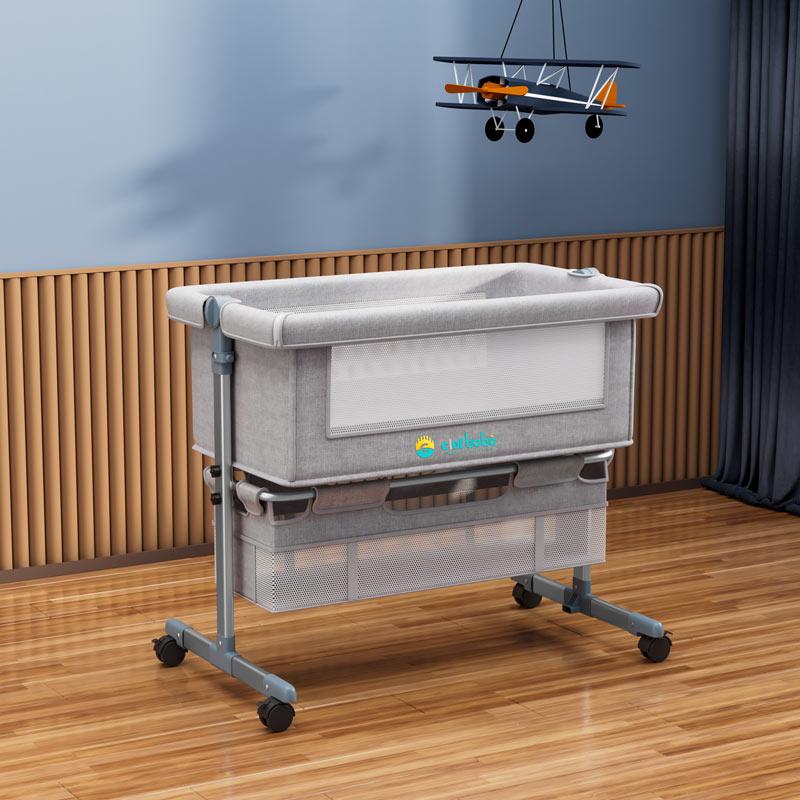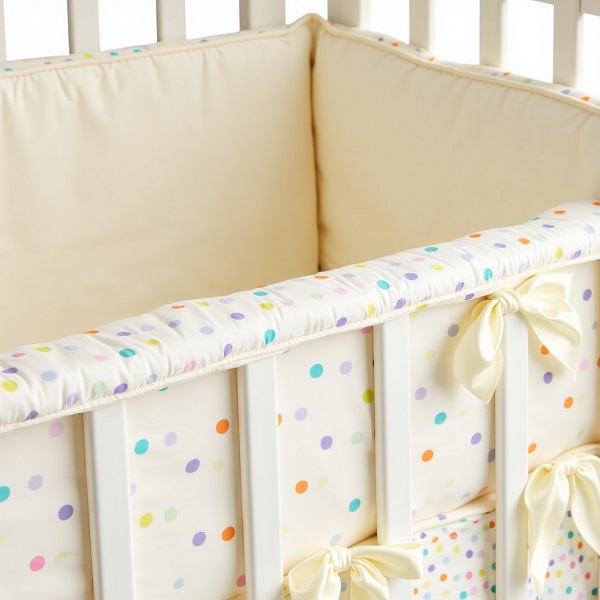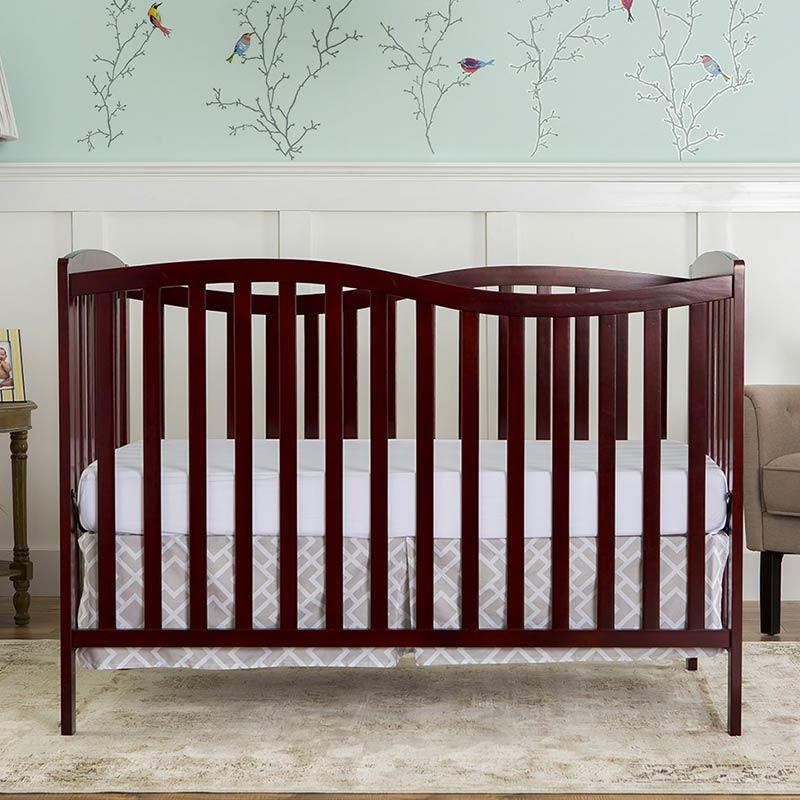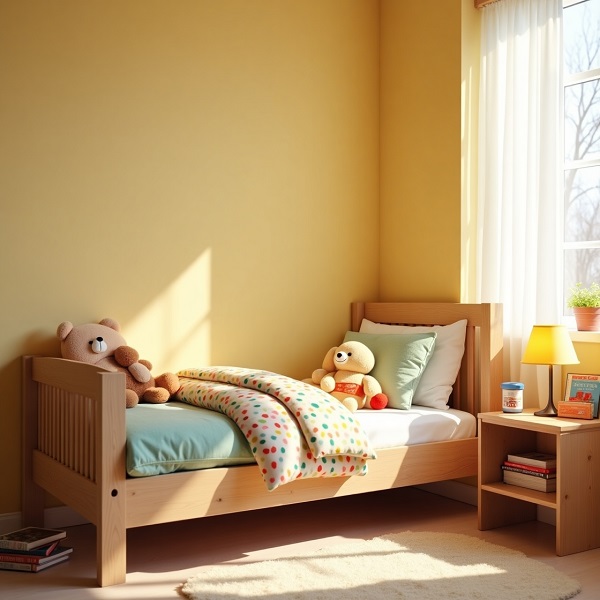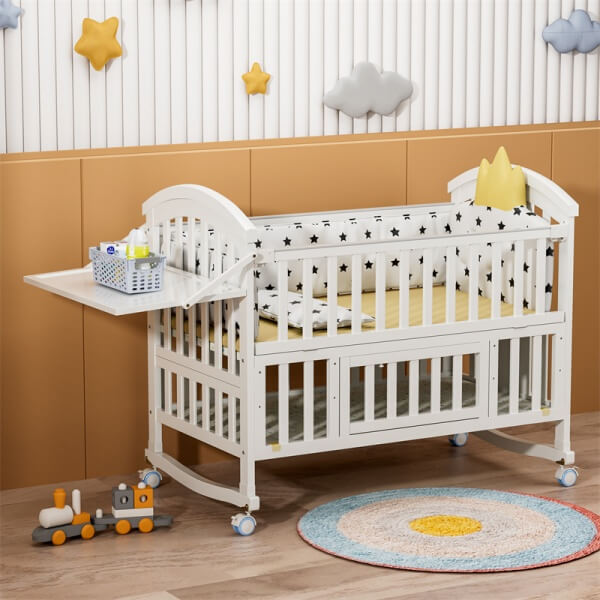Those first bleary-eyed weeks with a newborn are a blur of round-the-clock feedings, diaper changes, and—if you’re lucky—the occasional catnap. In the trenches of sleep deprivation, parents become experts at discovering what soothes their fussy little one. And more often than not, they rediscover an ancient trick that never fails: the gentle art of rocking.
You cradle your baby close, their warm weight snug in your arms as you sway in the dim glow of a nightlight. Slowly, their frantic cries soften into hiccups, then sighs. Those tiny eyelids—which seemed determined to stay open—finally fluttered shut. This scene reveals something powerful: newborns are hardwired to respond to rhythmic movement.
This instinct is exactly what makes keranjang bayi goyang so brilliant. They take that natural “off switch” (your aching arms) and automate it, blending the security of a cozy sleep space with the motion babies crave. But before you jump on the bandwagon, let’s address the big questions: Do these bassinets really work? Are they safe? And how do you choose the right one?
Why Do Babies like to Be Rocked?
There’s something almost primal about the way a baby’s cries quiet the moment they’re lifted into rocking arms. It’s not just parental instinct—it’s biology.
Before birth, your baby spent months in motion. Every time you walked, stretched, or even shifted in your seat, they floated in a rhythmic dance of amniotic fluid. Stillness? That was the rare exception. So when they’re born into a world where they’re often lying still in a crib, it’s no wonder they crave that familiar movement.
Researchers in developmental psychology have long noted that repetitive, rhythmic movement has a calming effect on infants. A 2013 study in Current Biology discovered something: When mothers walked while holding their babies, the infants’ heart rates slowed, their muscles relaxed, and they stopped crying far faster than when held in a still position. Researchers believe this response is deeply primal—rocking triggers neural pathways that signal safety, easing stress, and nudging babies toward sleep.
But it’s not just biology. Rocking offers A multisensory experience: the baby feels the physical sway, hears a soft whoosh of air, and often senses a comforting closeness. This combination of stimuli mimics the sensations of being carried, which signals to a baby that they are safe.
This explains why rocking bassinets can be so effective—they recreate that womb-like motion when your arms need a break.
Whether it’s in your arms, a rocking chair, or a bassinet, that steady sway speaks to something ancient in your baby’s brain, whispering: “You’re safe. You can rest now.”
What Is a Rocking Bassinet?
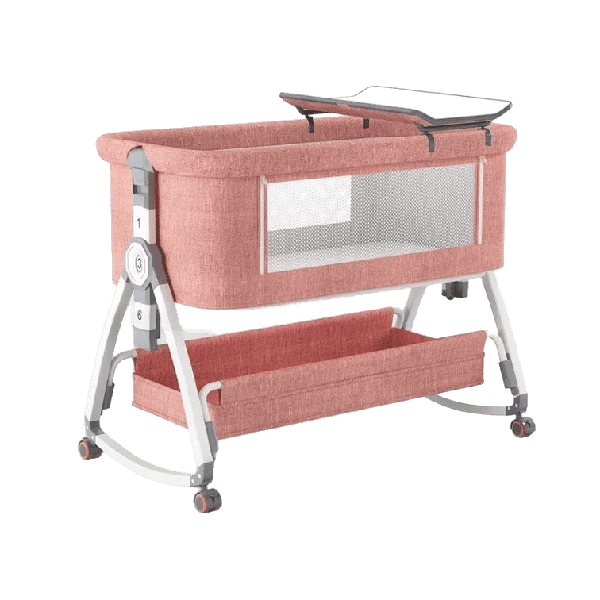
For generations, parents have instinctively rocked their babies to sleep, and the rocking bassinet brings that timeless comfort into modern nurseries. Unlike traditional stationary bassinets, these specialized sleep spaces are designed with a gentle rocking mechanism to mimic the natural motion babies experience when being held.
While the concept may sound modern, the idea of rocking an infant to sleep has deep historical roots—think of traditional cradle designs or mothers gently rocking babies in their arms. The rocking bassinet takes that age-old instinct and builds it into a purposefully designed product that supports safe infant sleep while easing the physical demands on caregivers.
There are generally two types of rocking bassinet: manual and electric (or automatic). Manual models move in response to a caregiver’s push or the baby’s own movement. Electric models, on the other hand, operate using a built-in motor to provide consistent, hands-free rocking.
Compared to other infant sleep solutions, rocking bassinets occupy a unique middle ground. Traditional bassinets provide a safe sleep surface but lack motion, which some babies desperately need. While swings and bouncers offer movement, they aren’t generally recommended for unsupervised sleep.
Full-size cribs, though essential for long-term use, don’t provide the soothing motion that helps many newborns transition to sleep.
The rocking bassinet combines the safety of a flat, firm sleep surface with the comforting motion that helps infants drift off more easily.
Is a Rocking Bassinet Safe for Newborns?
New parents often view baby products that promise better sleep with a mix of hope and caution—and rightly so. When it comes to rocking bassinets, safety is usually the first concern. The good news? When designed properly and used as directed, these bassinets can offer a safe and soothing sleep space for newborns.
The safest models feature gentle, controlled rocking that never tilts more than 15 degrees in either direction. This prevents the bassinet from moving too vigorously and ensures your baby stays in a secure position.
In addition, a wide, weighted base provides essential stability, while breathable mesh siding promotes crucial airflow around the sleeping infant. For automatic models, a secure rocking mechanism with locking capability offers added peace of mind when the motion feature isn’t needed.
Proper use plays an equally important role in ensuring safety. Parents should transition their baby to a stationary crib once the infant begins showing signs of rolling over. The sleep environment should remain free of any loose bedding, with only a fitted sheet covering the firm mattress.
The AAP includes rocking bassinets in their general safe sleep recommendations when these products meet all standar keselamatan. Their guidelines emphasize placing babies on their backs to sleep on a firm, flat surface free of loose bedding – advice that applies equally to stationary and rocking sleep spaces. While the AAP doesn’t specifically endorse rocking bassinets, they acknowledge these products can be appropriate when used correctly.
Benefits of Using a Rocking Bassinet for Newborns
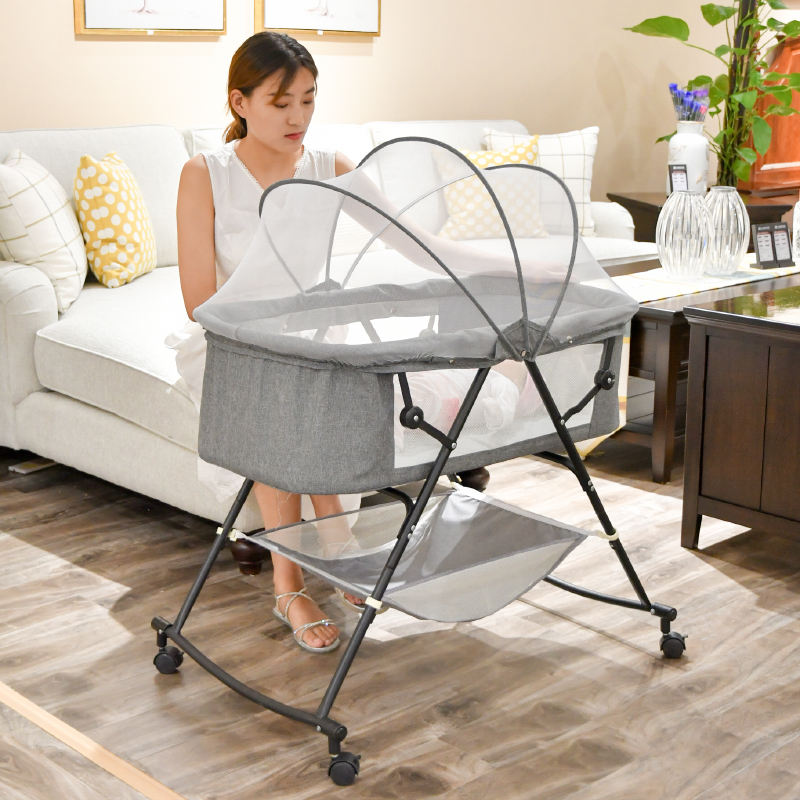
The first months with a newborn often feel like an endless cycle of feeding, rocking, and desperate attempts to sleep. This is where a well-designed rocking bassinet transitions from being just another nursery item to becoming what many parents describe as their “fourth-trimester survival tool.”
Sleep Quality and Duration Improvements
Unlike the fragmented sleep cycles common in stationary bassinets, the continuous rocking motion helps babies transition more smoothly between sleep phases.
Many parents report their infants fall asleep faster and stay asleep longer when using a rocking bassinet, particularly during the challenging first three months.
This isn’t just anecdotal – sleep studies demonstrate motion’s ability to prolong quiet sleep states in newborns. The effect resembles the natural sleep rhythm babies experience in the womb, where maternal movement creates constant motion.
Hands-Free Soothing for Tired Parents
A rocking bassinet can reduce the physical strain of constantly holding or bouncing a fussy baby, particularly helpful for parents recovering from childbirth or dealing with physical limitations.
The ability to soothe without picking up the baby minimizes sleep disruptions, allowing both the infant and parents to achieve more restorative rest.
Emotional and Psychological Impacts
Perhaps the most profound yet least discussed benefit is the reduction of parental stress and anxiety. When a crying baby finally settles into peaceful sleep through gentle rocking, it creates a positive feedback loop. Parents gain confidence in their ability to meet their baby’s needs, while infants develop trust in their environment.
Electric Vs Manual Rocking Bassinet: Which One to Choose?
| Fitur | Tempat Tidur Bayi Goyang Elektrik | Manual Rocking Bassinet |
| Operation | Hands-free; powered by motor (battery or plug-in) | Requires the parent to gently push or rock |
| Noise Level | May produce low hum from motor (varies by model) | Silent (no mechanical parts) |
| Portabilitas | Heavier, may need a power source | Lightweight; easy to move in the room |
| Soothing Features | Often includes extras like vibration, white noise, or nightlights | Typically, minimal or no added features |
| Biaya | Usually more expensive due to electronic components | More affordable and budget-friendly |
| Suitability for Long Nights | Great for overnight soothing with minimal effort | Less convenient during extended soothing needs |
The Case for Manual Rocking Bassinets
With no motors or electronics involved, these bassinets rely entirely on a caregiver’s gentle push to initiate movement. The motion tends to be more organic and variable, allowing you to adjust the rhythm based on your baby’s immediate response.
Without any mechanical components, there’s nothing to malfunction or require repairs. Many models can be converted to stationary bassinets when the rocking feature is no longer needed.
Namun, the manual approach does require physical effort, which can become tiring during those marathon rocking sessions at 3 AM. There’s also the limitation of having to be physically present to keep the rocking going – once you stop pushing, the motion gradually winds down.
The Advantages of Electric Rocking Bassinets
With just the press of a button, these bassinets provide consistent, hands-free motion that can continue uninterrupted for hours. Many models offer multiple speed settings, so you can customize the motion to match your baby’s comfort and soothing needs.
The automatic rocking allows caregivers to step away briefly while maintaining the soothing motion, whether to use the restroom, prepare a bottle, or simply take a mental health break.
However, electric models do come with some trade-offs. They’re generally more expensive, both upfront and potentially in ongoing costs (batteries or electricity). The mechanical components introduce more potential points of failure, though reputable brands design their products to be durable.
Key Decision Factors
When weighing your options, consider:
Your Budget – Manual models typically cost significantly less
Your Physical Capacity – Electric models reduce strain
Your Living Situation – Plug-in vs. battery power considerations
Your Baby’s Temperament – High-needs babies may benefit more from electric
Long-term Plans – Will you use it for subsequent children?
Can a Rocking Bassinet Soothe a Colicky Baby?
Colic is a distressing condition that affects up to 20% of newborns, typically marked by prolonged, unexplained crying spells in an otherwise healthy infant. Although the exact cause remains unclear, it is widely believed to involve a combination of gastrointestinal discomfort, sensory overstimulation, Dan an underdeveloped nervous system.
From a scientific standpoint, there is credible evidence that gentle, rhythmic motion can help calm distressed infants. A paper published in Current Biology by Esposito et al. demonstrated that babies carried by walking mothers showed an immediate calming response. This included a reduction in movement, heart rate, and crying—effects that were not observed when infants were simply held without motion.
Though the study focuses on parental carrying rather than bassinets specifically, it suggests that motion—regardless of source—can be effective in calming babies. A rocking bassinet replicates this rhythmic movement in a safe, hands-free manner, making it a reasonable tool to apply this natural calming response.
In a randomized controlled trial published in 2016 in the Journal of Pediatric Nursing, researchers compared the effects of massage and rocking on colicky infants. The results showed that while both methods offered some improvement, massage was significantly more effective in reducing crying duration and colic symptoms. The rocking group did show some benefit—but it was less dramatic.
The current body of scientific evidence supports the idea that gentle motion—whether through carrying, rocking, or vibration—can help soothe fussy and colicky babies. While a rocking bassinet may not “cure” colic, it can serve as a helpful, non-invasive tool to reduce distress and support sleep, especially when combined with other techniques.
Kesimpulan
Let’s be honest—those first few months with a newborn can feel like a marathon of sleepless nights. If you’re dealing with a fussy, colicky baby or just desperate for longer stretches of rest, a rocking bassinet might be the extra help you’ve been wishing for.
Yes, it’s not a magic fix—some babies will still prefer being held, and others might outgrow the motion quickly. But when used safely and as part of a broader soothing routine (think swaddling, white noise, and plenty of cuddles), it can make a real difference.
The rhythmic rocking recreates the gentle sway of the womb, helping newborns adjust to the outside world with a little more ease. And for exhausted parents? That hands-free soothing can mean the difference between another hour of sleep and another hour of pacing the nursery.
At the end of the day, the best choice is whatever works for your baby and your sanity. Whether you go for a simple manual rocker or an automated model, a rocking bassinet just might bring a little more peace—and a little more sleep—to your home.

